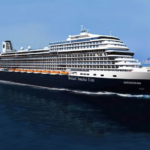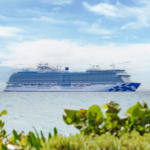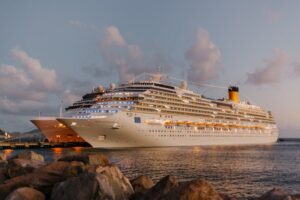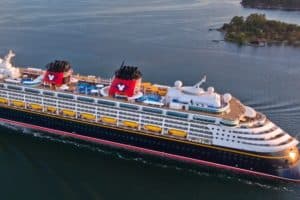Seeing a cruise ship for the very first time is a grand experience. You’ll get an insight not just into its beauty as it gracefully floats by but its sheer size as well. If you’re like me, you may have wondered, how much does a cruise ship weigh?
The weight of a typical modern-day large cruise ship is around 200,000 GT (gross tons). Gross registered tons (GRT) is used to calculate their weight and 1 GRT is equal to 100 cubic feet of enclosed space.
The weight of some of the most popular cruise ships are as follows:
- Symphony of the Seas: At 228,021 tons, this is the largest passenger cruise ship in the world by gross tonnage.
- Oasis of the Seas: This Royal Caribbean cruise ship weighs 225,282 tons and can carry 5,400 passengers.
- Anthem of the Seas: The latest in the Royal Caribbean Quantum line weighing 168,666 tons and caters to 4,180 passengers.
- Quantum of the Seas: A signature Royal Caribbean cruise ship with a weight of 167,800 tons and can accommodate up to 4,180 passengers.
- Norwegian Escape: Welcoming 4,200 passengers, this Norwegian Cruise Line weighs 165,300 tons.
- Norwegian Epic: Again, from the Norwegian Cruise Line, this mega-ship comes in at 155,873 tons and has a double-occupancy capacity of 4,100 passengers.
Cruise ships come in a wide variety of shapes and sizes. There are even cruise ships as long as four football fields combined and 20 or more stories high. These modern marvels of engineering are beyond what most of us can fully comprehend.
Cruise ships may be cumbersome, but their buoyancy provides them with the highest efficiency when they’re cutting through the swells of the ocean. But with this so much weight, how do cruise ships stay afloat on the water?
Read on to learn more about how many cruise ships weigh and how they can stay afloat.
Also, if you want to get off the cruise for a break, an inflatable paddle board is perfect for when you’re docked:
Click here to see it on Amazon.
What Exactly Is Gross Tonnage?
When it comes to cruise ship size, people normally compare the gross tonnage to another’s gross tonnage. So, the cruise ship Navigator of the Seas, with a weight of more than 137,000 gross tons, is considered smaller in size than the Oasis of the Seas, weighing at 225,282 tons.
Since tonnage is the measurement used concerning a ship’s measurement, we often assume its weight is its gross tonnage. However, tonnage is not weighted – it’s actually a volume measurement. So a cruise ship’s tonnage is its volume inside.
The development of this type of measurement is for assessing the cargo-carrying capacity of a vessel. The use of tons here distorts the word “tuns,” which is the old-fashioned term for barrels of wine.
As mentioned, the equivalent of one gross ton traditionally is 100 cubic feet of area. However, today, a specific formula is used to work out tonnage instead of 100 cubic feet to the ton. But it still represents the volume of space or the ship’s internal capacity.
Also, GT is different from displacement in terms of standard measurement. Displacement is a vessel’s actual weight. It is the weight of the water that cruise ships displace.
For example, a class of Oasis ships has a displacement of just around 100,000 tons, whereas the gross tonnage of these ships is more than double that number.
The deadweight of a cruise ship is also different from GT. Deadweight refers to the amount of load a vessel is allowed to carry onboard. This is far more vital to cargo ships than passenger ships.
So while the Oasis of the Sea has a gross tonnage of more than 220,000 GT, its deadweight is roughly 25,000 tons.
Staying Afloat
The displacement theory is utilized to determine a cruise ship’s weight: the water all ships need to place for it to stay afloat. Water can fill the corners of containers since it’s heavy.
Cruise ships, on the other hand, have a lot of open space. And since they are wide, long, and deep, they have adequate flotation by water displacement within the ocean.
Cruise Ship Draft
There are a few cruise ships that sit under the water. These ships are vast, enabling them to combat waves and swells of the ocean with ease.
Massive cruise ships will also sit less than 10 meters under the water’s surface, while most of their vessel can be seen above the water. Because of this, they can take on ocean waves and swells far better than smaller ships, an advantage that cruise ship operators have taken into consideration.
Weight and Capacity of the Most Popular Cruise Ships in the World
The latest trend in cruise ships is mega-ships. We can’t deny their popularity. Their designs can cater to all passenger types and groups. These are like floating cities jam-packed with attractions and entertainment to your heart’s desire, from adult-only spas to kids’ clubs.
It is quite mind-boggling how a ship can accommodate 4,000 passengers or even more. And let’s not forget about the crew and staff of the ship, which can sometimes total to 2,000 people. That’s a whopping 6,000 individuals adding more weight to the cruise ship.
Fortunately, only the best of the best technology and expertise is used to design these modern vessels. You can have peace of mind that they come with superior performance, stability, and space. It helps to list the weight of some of the most popular cruise ships to answer the question: “How much does a cruise ship weigh?”
- Symphony of the Seas: At 228,021 tons, this is the largest passenger cruise ship in the world by gross tonnage.
- Oasis of the Seas: This Royal Caribbean cruise ship weighs 225,282 tons and can carry 5,400 passengers.
- Anthem of the Seas: The latest in the Royal Caribbean Quantum line weighing 168,666 tons and caters to 4,180 passengers.
- Quantum of the Seas: A signature Royal Caribbean cruise ship with a weight of 167,800 tons and can accommodate up to 4,180 passengers.
- Norwegian Escape: Welcoming 4,200 passengers, this Norwegian Cruise Line weighs 165,300 tons.
- Norwegian Epic: Again, from the Norwegian Cruise Line, this mega-ship comes in at 155,873 tons and has a double-occupancy capacity of 4,100 passengers.
When you compare these vessels, you’ll have an idea of their sizes. As an example, the 10th heaviest cruise ship is the Queen Mary 2, at 149,215 tons. This is 40% less than the weight of the Allure of the Seas.
A Brief History of Cruise Ships
We can trace back the form of present-day cruising to the start of the 20th century during the peak of transoceanic travel.
Back in those days, ships were the only transportation mode, so companies in the industry made sure they offered only the best possible services to keep up with the competition. These luxurious services that ocean liners offer are what we now know as line voyages.
However, due to the length of the journey, with the shortest being four days, there is a need for massive storage for fuel and other essentials. As a result, that did not give luxuries much room.
As technology advances and jet airplanes were introduced during the latter part of the last century, passengers’ preferences shifted. This left lengthy sea journeys to those who are genuine sea enthusiasts.
Does Size Matter?
Generally, the larger-sized cruise ships offer more amenities and features.
The biggest cruise ships can hold up to 5,000 passengers and more. They offer almost anything under the sun, from bars, entertainment, pools, and restaurants, you name it, they got it. You can even do some shopping in your spare time in duty-free shops.
These cruises tend to be noisy, but you will be able to maintain your anonymity. Small cruise ships can hold only hundreds of passengers. Their public spaces are fewer, so your chances of bumping into your shipmates often are high.
They also offer a more relaxed ambiance, and their dining options lean more on quality than quantity.
It’s faster to disembark ships carrying less than 1,000 guests at every port. It’ll also be faster ordering your favorite breakfast and easier to grab a chaise lounge by the poolside.
On the other hand, it’ll take hours for you to get off on larger cruise ships, especially if they are anchored, and you need to wait for your turn to board a boat to reach ashore.
Choosing the size of the cruise will boil down to what kind of experience you’re after. Mega-ships offer a wide array of dining choices, entertainment options, and amenities.
They’re great if you’re looking to have the time of your life on board. Small cruises often offer an exclusive experience. They’re the perfect choice if you’re looking for a more intimate time with a loved one or you want to relax and enjoy the sea.
Conclusion – How Much Does a Cruise Ship Weigh?
To recap, how much does a cruise ship weigh? The weight of a typical modern-day large cruise ship is around 200,000 GT (gross tons). Gross registered tons (GRT) is used to calculate their weight, and 1 GRT is equal to 100 cubic feet of enclosed space.
The Oasis of the Seas and Allure of the Seas by the Royal Caribbean are the world’s largest cruise ships at 225,282 GT and 228,021 GT, respectively. Since 2001, around nine new vessels weighing over 100,000 GT are added to the list every year.
Basically, the larger a cruise ship’s tonnage is, the larger it is, and the more passengers, entertainment facilities, restaurants, and other amenities it can hold.
Related reading:
How Do Cruise Ships Not Tip Over?
What Is the Best Norwegian Cruise Ship?









